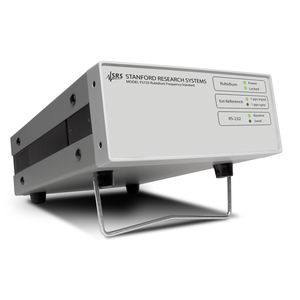
- Electricity - Electronics
- Electronic Component
- Crystal oscillator
- Stanford Research Systems
Crystal oscillator PRS10electronicwith connectorrubidium crystal
Add to favorites
Compare this product
Characteristics
- Type
- crystal
- Technology
- electronic
- Other characteristics
- with connector, rubidium crystal
- Electrical characteristics
- low phase noise, frequency
- Frequency
10 MHz
Description
The PRS10 is an ultra-low phase noise, 10 MHz rubidium-disciplined crystal oscillator. The device fulfills a variety of communication, synchronization and instrumentation requirements. The phase noise of the 10 MHz output is low enough to be used as the reference source for synthesizers. The unit's short-term stability and low environmental coefficients make it an ideal component for network synchronization. Its low aging rate makes it an excellent timebase for precision frequency measurements.
The PRS10 can time-tag an external 1 pps input with 1 ns resolution. These values may be reported back via RS-232, or used to phase-lock the unit to an external reference (such as GPS) with time constants of several hours. This feature can provide Stratum 1 performance at a very low cost.
The PRS10 establishes a new level of features and performance in atomic frequency standards. Its design provides the lowest phase noise, greatest versatility, and easiest path to system integration of any rubidium frequency standard available.
All commercial rubidium frequency standards operate by disciplining a crystal oscillator to the hyperfine transition at 6.834,682,612 GHz in rubidium. The amount of light from a rubidium discharge lamp that reaches a photodetector through a resonance cell will drop by about 0.1 % when the rubidium vapor in the resonance cell is exposed to microwave power near the transition frequency. The crystal oscillator is stabilized to the rubidium transition by detecting the light dip while sweeping an RF frequency synthesizer (referenced to the crystal) through the transition frequency.
Catalogs
Other Stanford Research Systems products
Time & Frequency Instruments
Related Searches
- Electronic filter
- Signal amplifying integrated circuit
- Passive electronic filter
- Low-pass electronic filter
- Crystal oscillator
- Electronic amplifying integrated circuit
- Electronic oscillator
- Instrumentation amplifier
- Voltage amplifying integrated circuit
- Analog amplifying integrated circuit
- High-pass electronic filter
- Adjustable amplifier
- Current amplifying integrated circuit
- Low-noise amplifying integrated circuit
- Benchtop amplifier
- Rack-mount amplifier
- Conditioning amplifier
- Frequency oscillator
- Signal preamplifier
- Differential amplifier
*Prices are pre-tax. They exclude delivery charges and customs duties and do not include additional charges for installation or activation options. Prices are indicative only and may vary by country, with changes to the cost of raw materials and exchange rates.









